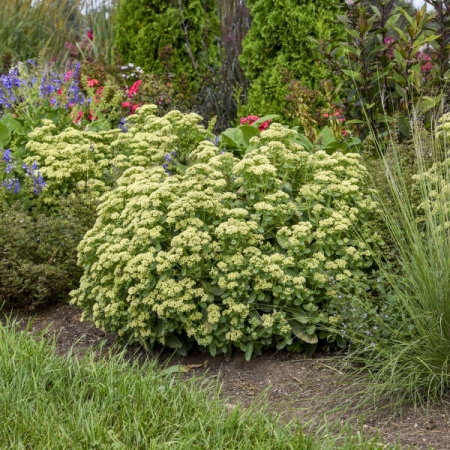Sedum (Autumn Stonecrop)
×
Color Name: Lemonjade
Unlike most autumn stonecrops which have pink flowers, 'Lemonjade' bears large 5-7" panicles of bright citron yellow flowers which completely cover the top of the foliage in early fall. As the cold weather sets in, the seed heads take on rosy peach tones.
This is a compact selection with a stocky, upright mounded habit. It does not split open when it blooms like so many older Sedums do. Its grey-green, toothed foliage remains clean all season long.
Tall, upright sedums form substantial clumps of foliage which can be substituted for shrubs in the landscape. Their stout, sturdy stems support the massive flower heads which develop in summer and burst into bloom in fall. If left standing, they provide winter interest and food for birds.
Growing Tips: Sedum is one of the most popular perennials grown in American gardens because it is very easy to grow and hardy in most areas of the country. Because of its thick, succulent leaves which can store water, sedum is drought tolerant. It should be sited in average to poor soil that is well-drained. Plants grown in rich soil tend to be lanky and open. Most varieties should be grown in full sun to light shade. The lower growing types, however, will survive in partial shade. This plant is not usually bothered by pests or diseases. The seed heads of the taller varieties provide excellent winter interest and food for birds. Remove them in spring when the new growth begins to show.
Photo courtesy of Walters Garden, Inc.
Unlike most autumn stonecrops which have pink flowers, 'Lemonjade' bears large 5-7" panicles of bright citron yellow flowers which completely cover the top of the foliage in early fall. As the cold weather sets in, the seed heads take on rosy peach tones.
This is a compact selection with a stocky, upright mounded habit. It does not split open when it blooms like so many older Sedums do. Its grey-green, toothed foliage remains clean all season long.
Tall, upright sedums form substantial clumps of foliage which can be substituted for shrubs in the landscape. Their stout, sturdy stems support the massive flower heads which develop in summer and burst into bloom in fall. If left standing, they provide winter interest and food for birds.
Growing Tips: Sedum is one of the most popular perennials grown in American gardens because it is very easy to grow and hardy in most areas of the country. Because of its thick, succulent leaves which can store water, sedum is drought tolerant. It should be sited in average to poor soil that is well-drained. Plants grown in rich soil tend to be lanky and open. Most varieties should be grown in full sun to light shade. The lower growing types, however, will survive in partial shade. This plant is not usually bothered by pests or diseases. The seed heads of the taller varieties provide excellent winter interest and food for birds. Remove them in spring when the new growth begins to show.
Photo courtesy of Walters Garden, Inc.
|
Flower Color: Yellow Shades Foliage Color: Green Shades
Height: 16 to 20 Inches Spread: 24 to 28 Inches Hardy in Zone: 4, 5, 6, 7 |
Blooms: Fall Late Summer
Foliage Season: All Season |
Growth Rate |
Medium
|
Attributes |
Container Dried Flower Border Cut Flower or Foilage Drought Tolerant Easy to Grow Landscapes Mass Planting Salt Tolerant
|








